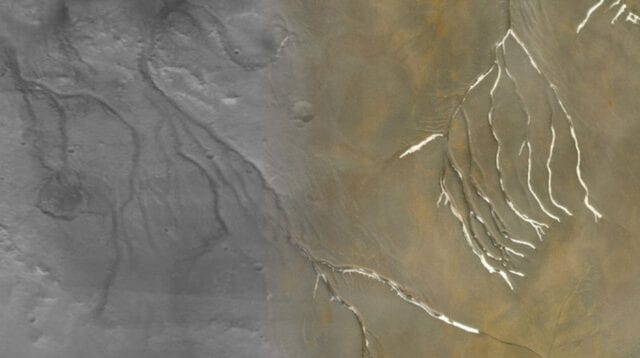
Ice sheets, and not rushing rivers, sculpted many Martian valleys, according to scientists. The new research suggests ancient Mars wasn’t as warm and wet as we thought, but an expert we spoke to remains unconvinced.
New research published in Nature Geoscience suggests rushing rivers weren’t responsible for the distinctive shape of certain Martian valleys located in the planet’s southern highlands. Rather, these geological features were forged by melting water coursing beneath gigantic glaciers, in a geological process known as subglacial erosion. Ancient Mars, the new research suggests, was likely cold and icy, and not the temperate wet planet it’s often presumed to be.
“Our study challenges the widely held view that most valley networks on Mars were formed by rivers fed by precipitation,” explained Gordon Osinski, a co-author of the new paper and a planetary geologist from Western University, in a Western press release. “While we found evidence consistent with a small handful of valley networks having formed in this way, our observations suggest that the majority formed beneath ice sheets.”
Interestingly, these results, while surprising, seem to match the results from climate models. Computer simulations of ancient Mars suggest the Red Planet was cold and covered with ice some 3.8 billion years ago.
For the new study, Osinski, along with Anna Grau Galofre from Arizona State University and Mark Jellinek from the University of British Columbia, examined satellite photos of 10,276 individual valleys found in 66 valley networks on Mars, which they did using custom-built software. Their algorithm was able to match surface features to specific erosional processes, including glacial, subglacial, fluvial (surface water), and sapping (ground water) erosion.
G/O Media may get a commission
“If you look at Earth from a satellite, you see a lot of valleys: Some of them made by rivers, some made by glaciers, some made by other processes, and each type has a distinctive shape,” explained Grau Galofre in an ASU press release. “Mars is similar, in that valleys look very different from each other, suggesting that many processes were at play to carve them.”
Martian valleys were also compared to known subglacial features on Earth. Devon Island, located in the Canadian Arctic, is “one of the best analogues we have for Mars here on Earth,” said Osinski, as it’s a “cold, dry polar desert and we know the glaciation is largely cold-based.”
Of the 66 valley systems studied, the researchers identified 22 as being formed from subglacial erosion: 14 fluvial, nine glacial, three sapping, and 18 indeterminate. These findings are “the first evidence for extensive subglacial erosion driven by channelized meltwater drainage beneath an ancient ice sheet on Mars,” said Jellinek in the ASU press release, adding that these results “demonstrate that only a fraction of valley networks match patterns typical of surface water erosion, which is in marked contrast to the conventional view.”
Bruce Jakosky, a geology professor at the University of Colorado and Principal Investigator on the Mars Atmosphere and Volatile Evolution (MAVEN) mission, described the new analysis as “interesting” but not “definitive.”
“Based on their figures, there appears to be a smooth gradation between the properties of the individual valley networks,” said Jakosky in an email. “Having a smooth gradation in properties, but classifying them into a limited number of formation processes, seems to leave one open to significant uncertainties.”
As a result, Jakosky is not very confident in the specific numbers used in the study. He was also unimpressed with the relatively small sample size of 66, given the authors’ declaration that “hundreds” of valley networks exist on Mars.
“With the exception of the low number for sapping erosion, this seems consistent with a random distribution between the other processes,” he explained. “That is, even though subglacial erosion is the most prominent, it is not so dominant as to justify a conclusion that they are the major process. That is, they state that subglacial and fluvial dominate, but it looks more roughly equal among all processes.”
To which he added: “Their conclusions should have been that all of the processes that they examined played a role, and we have to look for a climate/environment that could support all of them.”
Scott King a geoscientist from Virginia Tech, found the new result to be reasonable, and even likely.
“I think the problem is that it’s Mars and we have some pretty strong ideas about Mars and sometimes that gets in the way of our looking at the observations,” wrote King in an email. “This is one of those studies that makes us stop and ask ourselves just why did we assume that all the valley networks on Mars were fluvial? Why wouldn’t both fluvial and glacial erosion have occurred on Mars? The climate models tell us that Mars was cold and icy so these researchers asked a very logical question, ‘what kind of valley networks do we see?’”
Indeed, the new data has to be reconciled with other geological evidence from ancient Mars, such as the sites of former lakes and river deltas (including Jezero crater, the destination site for the Mars Perseverance rover), clay formations (as discovered by the Curiosity rover), and even evidence of an ancient mega-tsunami on Mars.
Ancient Mars was wet, but the new paper complicates our understanding of this planet’s past by showing how erosional processes other than free-flowing surface water can sculpt certain geological features. Moving forward, planetary scientists would do well to remember this paper, even if it’s somewhat incomplete. It’s becoming increasingly clear, however, that ancient Mars was a complex and dynamic place.
Source: gizmodo.com








